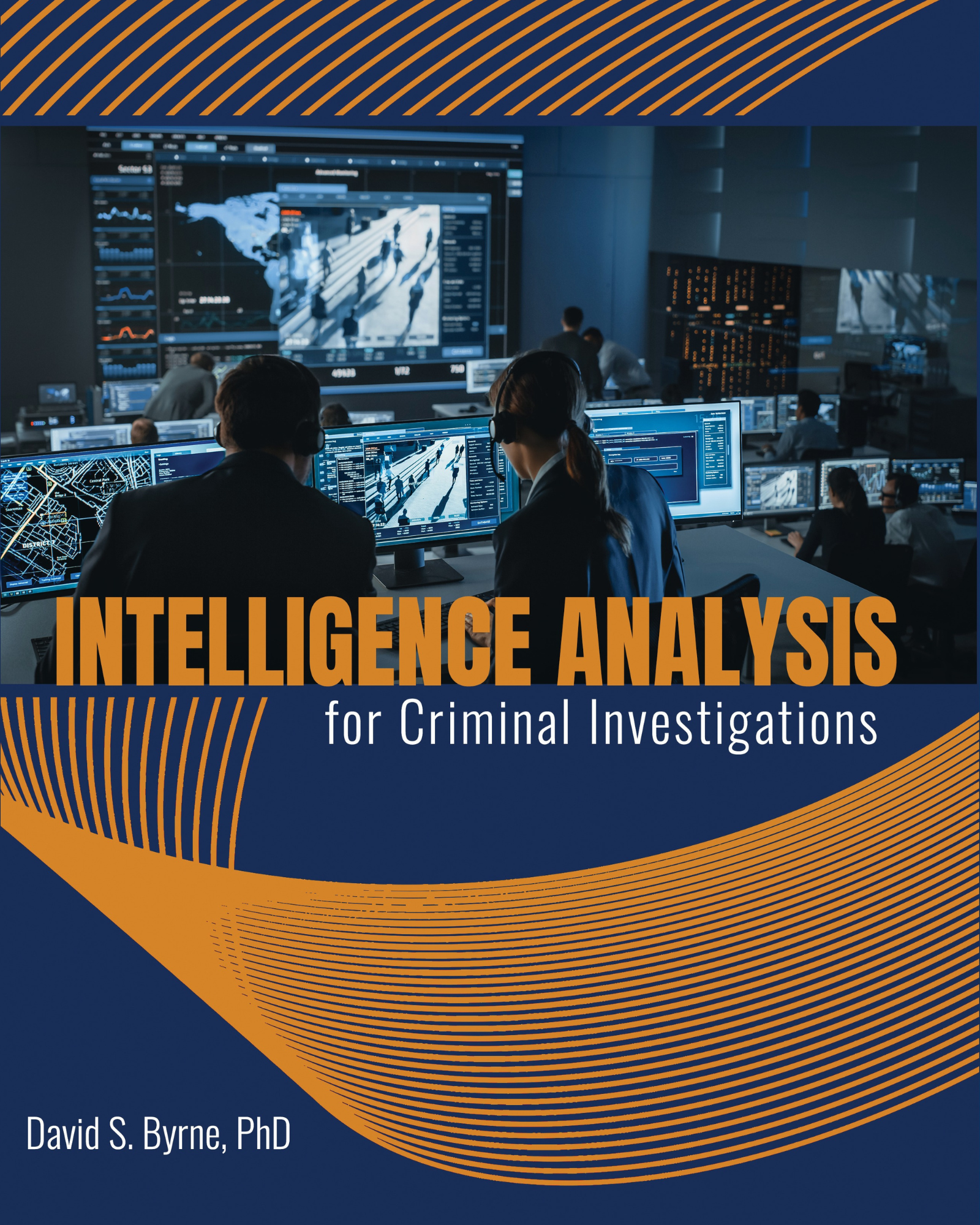Intelligence Analysis for Criminal Investigations
Author(s): David Byrne
Edition: 1
Copyright: 2023
Pages: 102
$65.00 USD
This product is currently not available.
This one-of-kind Workbook contains over 40 Activities, 22 Topics, 2 Investigation Case Studies and 2 Intelligence Briefing Reports. It also covers everything an Intelligence Analyst would need in handling a criminal investigation including tactics to collect information, an affidavit and search warrant template, methods to analyze telephonic and financial records and strategies in creating visuals including link analysis charts, association matrixes, telephone spoke charts, and financial activity flow charts.
TOPIC 1: TYPES OF INTELLIGENCE
ACTIVITY: TYPES OF INTELLIGENCE
INVESTIGATION CASE STUDY #1
TOPIC 2: START OF INVESTIGATION —FACT PATTERN
ACTIVITY: IDENTIFICATION OF SUSPECTS AND DETAILS
TOPIC 3: 28 CFR 23
ACTIVITY: IDENTIFICATION OF SUSPECTS AND DATABASE ENTRIES
TOPIC 4: ASSOCIATION MATRIX
ACTIVITY: DRAFT AN ASSOCIATION MATRIX
TOPIC 5: LINK ANALYSIS CHART
ACTIVITY: DRAFT A LINK ANALYSIS CHART
TOPIC 6: EVENT MATRIX
ACTIVITY: DRAFT AN EVENT MATRIX
TOPIC 7: RESEARCH THE CRIME
ACTIVITY: PERFORM RESEARCH ABOUT THE CRIME
TOPIC 8: TYPES OF INFORMATION
TOPIC 9: COLLECTION STRATEGY
ACTIVITY: COLLECTION STRATEGY
SEARCH WARRANT
TOPIC 10: SEARCH WARRANT AND AFFIDAVIT
ACTIVITY: DRAFT AN AFFIDAVIT
TOPIC 11: ESTABLISHING PROBABLE CAUSE
ACTIVITY: DRAFT PROBABLE CAUSE COMPONENT
TOPIC 12: SEARCH WARRANT
ACTIVITY: DRAFT A SEARCH WARRANT
TOPIC 13: INSTRUCTIONS FOR THE SEIZED ITEMS
ACTIVITY: DRAFT FINAL SECTION OF SEARCH WARRANT
TELEPHONIC RECORDS
TOPIC 14: PHONE RECORDS
ACTIVITY: SEARCH WARRANT RESULTS—CDR REVIEW
ACTIVITY: TELEPHONE CALL MATRIX
ACTIVITY: CALLS ORGANIZATION
TOPIC 15: TELEPHONE SPOKE CHART
ACTIVITY: DRAFT A TELEPHONE SPOKE CHART
ACTIVITY: CONCLUSIONS FROM PHONE RECORDS
TOPIC 16: PHOTOS AND SOCIAL MEDIA POSTS FROM CELL PHONE
ACTIVITY: PHOTOS AND SOCIAL MEDIA FROM CELL PHONE
SEARCH WARRANT PHYSICAL EVIDENCE
TOPIC 17: ITEMS SEIZED FROM GAS STATION
ACTIVITY: ITEMS SEIZED FROM GAS STATION
FINANCIAL RECORDS
TOPIC 18: FINANCIAL RECORDS
ACTIVITY: BANK STATEMENT RECEIVED
TOPIC 19: MONEY LAUNDERING
TOPIC 20: FINANCIAL ACTIVITY FLOW CHART EXAMPLE
TOPIC 21: NEW INFORMATION RECEIVED
ACTIVITY: DRAFT A FINANCIAL ACTIVITY FLOW CHART
INTELLIGENCE BRIEFING REPORT
ACTIVITY: INTELLIGENCE BRIEFING 1
ACTIVITY: INTELLIGENCE BRIEFING 2
ACTIVITY: INTELLIGENCE BRIEFING 3
ACTIVITY: DRAFT AN INTELLIGENCE BRIEFING 4
INVESTIGATION CASE STUDY #2
TOPIC 22: START OF NEW INVESTIGATION - (FACT PATTERN)
ACTIVITY: IDENTIFICATION OF SUSPECTS AND DETAILS
ACTIVITY: DRAFT AN ASSOCIATION MATRIX
ACTIVITY: DRAFT A LINK ANALYSIS CHART
ACTIVITY: DRAFT AN EVENT MATRIX
ACTIVITY: PERFORM RESEARCH ABOUT THE CRIME
ACTIVITY: COLLECTION STRATEGY
SEARCH WARRANT
ACTIVITY: DRAFT AN AFFIDAVIT
ACTIVITY: DRAFT PROBABLE CAUSE COMPONENT
ACTIVITY: DRAFT A SEARCH WARRANT
ACTIVITY: DRAFT FINAL SECTION OF SEARCH WARRANT
TELEPHONIC RECORDS
ACTIVITY: SEARCH WARRANT RESULTS – CDR REVIEW
ACTIVITY: TELEPHONE CALL MATRIX
INTELLIGENCE BRIEFING REPORT
ACTIVITY: INTELLIGENCE BRIEFING 1
ACTIVITY: INTELLIGENCE BRIEFING 2
ACTIVITY: INTELLIGENCE BRIEFING 3
ACTIVITY: DRAFT AN INTELLIGENCE BRIEFING 4
Dr. David S. Byrne is currently an Assistant Professor at St. John's University in the Criminal Justice & Homeland Security department and teaches courses in Crime Scene Investigation, Intelligence Analysis, Criminal Investigations, and Counterterrorism. Dr. Byrne has over 15 years of experience in law enforcement, having provided intelligence analytical support in cases involving violent transnational criminal organizations. He was also cross-designated as a Special Detective Investigator for the District Attorney offices in Queens, Richmond, and Manhattan counties in New York where he assisted in the investigation and prosecution of organized crime networks involved in narcotics trafficking, violent extortions, and racketeering offenses.
Since 2015, he also taught at SUNY Farmingdale College, Center for Criminal Justice; courses included Criminalistics, Computer Forensics, and Intelligence Operations. Dr. Byrne was the recipient of the prestigious SUNY Chancellor's Award for Excellence in Adjunct Teaching (2023-2024) and received two grants for the development of a Mock Crime Scene simulation program at the school, see https://youtu.be/uwJahkCNsnA
Dr. Byrne's teaching method focuses on applied and experiential learning through the incorporation of hands-on learning activities to improve student outcomes, critical thinking skills, and long-term knowledge retention. His research interests focus on improving criminal justice education via technology simulations, cybersecurity, digital forensics, and intelligence studies and has published articles in these areas in scholarly journals and authored two books.
Dr. David Byrne earned his Doctorate (Ph.D.) in Information Science with a concentration in Criminal Justice Technologies, a Master of Science in Criminal Justice both from LIU Post, New York and a second Masters in Library & Information Science, from St. John's University in New York.
This one-of-kind Workbook contains over 40 Activities, 22 Topics, 2 Investigation Case Studies and 2 Intelligence Briefing Reports. It also covers everything an Intelligence Analyst would need in handling a criminal investigation including tactics to collect information, an affidavit and search warrant template, methods to analyze telephonic and financial records and strategies in creating visuals including link analysis charts, association matrixes, telephone spoke charts, and financial activity flow charts.
TOPIC 1: TYPES OF INTELLIGENCE
ACTIVITY: TYPES OF INTELLIGENCE
INVESTIGATION CASE STUDY #1
TOPIC 2: START OF INVESTIGATION —FACT PATTERN
ACTIVITY: IDENTIFICATION OF SUSPECTS AND DETAILS
TOPIC 3: 28 CFR 23
ACTIVITY: IDENTIFICATION OF SUSPECTS AND DATABASE ENTRIES
TOPIC 4: ASSOCIATION MATRIX
ACTIVITY: DRAFT AN ASSOCIATION MATRIX
TOPIC 5: LINK ANALYSIS CHART
ACTIVITY: DRAFT A LINK ANALYSIS CHART
TOPIC 6: EVENT MATRIX
ACTIVITY: DRAFT AN EVENT MATRIX
TOPIC 7: RESEARCH THE CRIME
ACTIVITY: PERFORM RESEARCH ABOUT THE CRIME
TOPIC 8: TYPES OF INFORMATION
TOPIC 9: COLLECTION STRATEGY
ACTIVITY: COLLECTION STRATEGY
SEARCH WARRANT
TOPIC 10: SEARCH WARRANT AND AFFIDAVIT
ACTIVITY: DRAFT AN AFFIDAVIT
TOPIC 11: ESTABLISHING PROBABLE CAUSE
ACTIVITY: DRAFT PROBABLE CAUSE COMPONENT
TOPIC 12: SEARCH WARRANT
ACTIVITY: DRAFT A SEARCH WARRANT
TOPIC 13: INSTRUCTIONS FOR THE SEIZED ITEMS
ACTIVITY: DRAFT FINAL SECTION OF SEARCH WARRANT
TELEPHONIC RECORDS
TOPIC 14: PHONE RECORDS
ACTIVITY: SEARCH WARRANT RESULTS—CDR REVIEW
ACTIVITY: TELEPHONE CALL MATRIX
ACTIVITY: CALLS ORGANIZATION
TOPIC 15: TELEPHONE SPOKE CHART
ACTIVITY: DRAFT A TELEPHONE SPOKE CHART
ACTIVITY: CONCLUSIONS FROM PHONE RECORDS
TOPIC 16: PHOTOS AND SOCIAL MEDIA POSTS FROM CELL PHONE
ACTIVITY: PHOTOS AND SOCIAL MEDIA FROM CELL PHONE
SEARCH WARRANT PHYSICAL EVIDENCE
TOPIC 17: ITEMS SEIZED FROM GAS STATION
ACTIVITY: ITEMS SEIZED FROM GAS STATION
FINANCIAL RECORDS
TOPIC 18: FINANCIAL RECORDS
ACTIVITY: BANK STATEMENT RECEIVED
TOPIC 19: MONEY LAUNDERING
TOPIC 20: FINANCIAL ACTIVITY FLOW CHART EXAMPLE
TOPIC 21: NEW INFORMATION RECEIVED
ACTIVITY: DRAFT A FINANCIAL ACTIVITY FLOW CHART
INTELLIGENCE BRIEFING REPORT
ACTIVITY: INTELLIGENCE BRIEFING 1
ACTIVITY: INTELLIGENCE BRIEFING 2
ACTIVITY: INTELLIGENCE BRIEFING 3
ACTIVITY: DRAFT AN INTELLIGENCE BRIEFING 4
INVESTIGATION CASE STUDY #2
TOPIC 22: START OF NEW INVESTIGATION - (FACT PATTERN)
ACTIVITY: IDENTIFICATION OF SUSPECTS AND DETAILS
ACTIVITY: DRAFT AN ASSOCIATION MATRIX
ACTIVITY: DRAFT A LINK ANALYSIS CHART
ACTIVITY: DRAFT AN EVENT MATRIX
ACTIVITY: PERFORM RESEARCH ABOUT THE CRIME
ACTIVITY: COLLECTION STRATEGY
SEARCH WARRANT
ACTIVITY: DRAFT AN AFFIDAVIT
ACTIVITY: DRAFT PROBABLE CAUSE COMPONENT
ACTIVITY: DRAFT A SEARCH WARRANT
ACTIVITY: DRAFT FINAL SECTION OF SEARCH WARRANT
TELEPHONIC RECORDS
ACTIVITY: SEARCH WARRANT RESULTS – CDR REVIEW
ACTIVITY: TELEPHONE CALL MATRIX
INTELLIGENCE BRIEFING REPORT
ACTIVITY: INTELLIGENCE BRIEFING 1
ACTIVITY: INTELLIGENCE BRIEFING 2
ACTIVITY: INTELLIGENCE BRIEFING 3
ACTIVITY: DRAFT AN INTELLIGENCE BRIEFING 4
Dr. David S. Byrne is currently an Assistant Professor at St. John's University in the Criminal Justice & Homeland Security department and teaches courses in Crime Scene Investigation, Intelligence Analysis, Criminal Investigations, and Counterterrorism. Dr. Byrne has over 15 years of experience in law enforcement, having provided intelligence analytical support in cases involving violent transnational criminal organizations. He was also cross-designated as a Special Detective Investigator for the District Attorney offices in Queens, Richmond, and Manhattan counties in New York where he assisted in the investigation and prosecution of organized crime networks involved in narcotics trafficking, violent extortions, and racketeering offenses.
Since 2015, he also taught at SUNY Farmingdale College, Center for Criminal Justice; courses included Criminalistics, Computer Forensics, and Intelligence Operations. Dr. Byrne was the recipient of the prestigious SUNY Chancellor's Award for Excellence in Adjunct Teaching (2023-2024) and received two grants for the development of a Mock Crime Scene simulation program at the school, see https://youtu.be/uwJahkCNsnA
Dr. Byrne's teaching method focuses on applied and experiential learning through the incorporation of hands-on learning activities to improve student outcomes, critical thinking skills, and long-term knowledge retention. His research interests focus on improving criminal justice education via technology simulations, cybersecurity, digital forensics, and intelligence studies and has published articles in these areas in scholarly journals and authored two books.
Dr. David Byrne earned his Doctorate (Ph.D.) in Information Science with a concentration in Criminal Justice Technologies, a Master of Science in Criminal Justice both from LIU Post, New York and a second Masters in Library & Information Science, from St. John's University in New York.


